
Moral Development and Intuition in Adolescents
Explore the stages of moral reasoning in adolescents, from following rules to advocating for higher principles. Learn how moral intuition influences decision-making and examine moral dilemmas such as looting after disasters.
Download Presentation

Please find below an Image/Link to download the presentation.
The content on the website is provided AS IS for your information and personal use only. It may not be sold, licensed, or shared on other websites without obtaining consent from the author. If you encounter any issues during the download, it is possible that the publisher has removed the file from their server.
You are allowed to download the files provided on this website for personal or commercial use, subject to the condition that they are used lawfully. All files are the property of their respective owners.
The content on the website is provided AS IS for your information and personal use only. It may not be sold, licensed, or shared on other websites without obtaining consent from the author.
E N D
Presentation Transcript
Topic 6.6- Moral Development This Photo by Unknown Author is licensed under CC BY-SA 1
Building Toward Moral Reasoning Adolescents see justice and fairness in terms of merit and equity instead of in terms of everyone getting equal treatment. Adolescents may strive to advocate for ideals and political causes. Adolescents think about god, meaning, and purpose in deeper terms than in childhood. Lawrence Kohlberg s Levels of Moral Reasoning Preconventional morality (up to age 9): Follow the rules because if you don t, you ll get in trouble; if you do, you might get a treat. Conventional morality (early adolescence): Follow the rules because we get along better if everyone does the right thing. Postconventional morality (later adolescence and adulthood): Sometimes rules need to be set aside to pursue higher principles. 2
Moral Intuition Jonathan Haidt believed moral decisions are often driven by moral intuition, that is, quick, gut-feeling decisions. This intuition is not just based in moral reasoning but also in emotions such as: disgust. We may turn away from choosing an action because it feels awful. elevated feelings. We may get a rewarding delight from some moral behavior such as donating to charity. An Example of Moral Intuition: Given a hypothetical choice to save five people from an oncoming trolley by killing one person, many people s choice is determined not just by reasoning, but by disgust. Many people would flip a switch to make this choice, but not as many would push a person on the tracks to save five others. 3
Example: looting after a natural disaster Which level of moral reasoning is involved? Looting is a problem; if everyone did it, there would be escalating chaos and greater damage to the economy. Looting is generally wrong, yet morally right when your family s survival seems to depend on it. Looting is wrong because you might get punished, but if no one is punished, that s a sign that it s okay. 4
